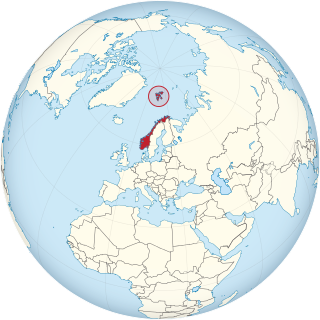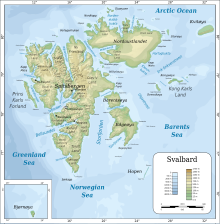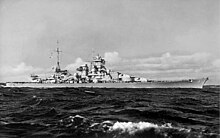
Svalbard, previously known as Spitsbergen or Spitzbergen, is a Norwegian archipelago in the Arctic Ocean. North of mainland Europe, it lies about midway between the northern coast of Norway and the North Pole. The islands of the group range from 74° to 81° north latitude, and from 10° to 35° east longitude. The largest island is Spitsbergen, followed in size by Nordaustlandet and Edgeøya. The largest settlement is Longyearbyen on the west coast of Spitsbergen.

Spitsbergen is the largest and the only permanently populated island of the Svalbard archipelago in northern Norway.

Admiral Scheer was a Deutschland-class heavy cruiser which served with the Kriegsmarine (Navy) of Nazi Germany during World War II. The vessel was named after Admiral Reinhard Scheer, German commander in the Battle of Jutland. She was laid down at the Reichsmarinewerft shipyard in Wilhelmshaven in June 1931 and completed by November 1934. Originally classified as an armored ship by the Reichsmarine, in February 1940 the Germans reclassified the remaining two ships of this class as heavy cruisers.

Operation Gauntlet was an Allied Combined Operation from 25 August until 3 September 1941, during the Second World War. Canadian, British and the Norwegian armed forces in exile landed on the Norwegian island of Spitzbergen in the Svalbard Archipelago, 650 mi (1,050 km) south of the North Pole.
The polar archipelago of Svalbard was first discovered by Willem Barentsz in 1596, although there is disputed evidence of use by Pomors or Norsemen. Whaling for bowhead whales started in 1611, dominated by English and Dutch companies, though other countries participated. At that time there was no agreement about sovereignty. Whaling stations, the largest being Smeerenburg, were built during the 17th century, but gradually whaling decreased. Hunting was carried out from the 17th century by Pomors, but from the 19th century it became more dominated by Norwegians.

Operation Sportpalast, also known as Operation Nordmeer, was a German naval raid between 6 and 13 March 1942 against two of the Allied Arctic convoys of World War II as they passed through the Norwegian Sea. It was conducted by the battleship Tirpitz, three destroyers and eight submarines. The German ships were unable to locate either of the convoys but sank a merchant vessel that was sailing independently. The Allies attempted to intercept the German force, also without success.

Operation Tungsten was a Second World War Royal Navy air raid that targeted the German battleship Tirpitz. The operation sought to damage or destroy Tirpitz at her base in Kaafjord in the far north of Norway before she could become fully operational again following a period of repairs.
Arktikugol is a Russian coal mining unitary enterprise which operates on the island of Spitsbergen in Svalbard, Norway. Owned by the government of Russia, Arktikugol currently performs limited mining in Barentsburg. It has carried out mining operations in the towns of Pyramiden and Grumant, which it still owns, and once operated a port at Colesbukta. The company is headquartered in Moscow and is the official agency through which Russia, and previously the Soviet Union, exercised its Svalbard policy.

Operation Haudegen was the name of a German operation during the Second World War to establish meteorological stations on the Svalbard archipelago in Norway. In September 1944, the submarine U-307 and the supply ship Carl J. Busch transported the men of Unternehmen Haudegen to the island. The station was active from 9 September 1944. On May 8, 1945, the staff received a message from their commanders in Tromsø that Germany had surrendered and the war was over. After that, radio contact was lost. The soldiers were capable of asking for support only in August 1945 and on 6 September, were picked up by a Norwegian seal hunting vessel and surrendered to its captain. The group of men were the last German troops to surrender after the Second World War.

Operation Fritham was an Allied military operation during the Second World War to secure the coal mines on Spitsbergen, the main island of the Svalbard Archipelago, 650 mi (1,050 km) from the North Pole and about the same distance from Norway. The operation was intended to deny the islands to Nazi Germany.

Z33 was a Type 1936A (Mob) destroyer built for the Kriegsmarine during World War II. Completed in 1943, the ship was damaged during the raid on the island of Spitsbergen in September and spent all of 1944 in Norwegian waters. She was damaged by British aircraft attacking the battleship Tirpitz in July. Z33 escorted troop convoys from northern Norway when the Germans began evacuating the area beginning in October. She ran aground in early 1945 as she was sailing for the Baltic and was badly damaged. While the ship was being towed to port for repairs, she and her escorts were attacked by Allied fighter-bombers. Z33 finally reached the Baltic in early April, but was reduced to reserve for lack of fuel. The ship was transferred to Cuxhaven and decommissioned shortly before the end of the war.

Tirpitz was the second of two Bismarck-class battleships built for Nazi Germany's Kriegsmarine (navy) prior to and during the Second World War. Named after Grand Admiral Alfred von Tirpitz, the architect of the Kaiserliche Marine, the ship was laid down at the Kriegsmarinewerft in Wilhelmshaven in November 1936 and her hull was launched two and a half years later. Work was completed in February 1941, when she was commissioned into the German fleet. Like her sister ship, Bismarck, Tirpitz was armed with a main battery of eight 38-centimetre (15 in) guns in four twin turrets. After a series of wartime modifications she was 2000 tonnes heavier than Bismarck, making her the heaviest battleship ever built by a European navy.

Z20 Karl Galster was one of six Type 1936 destroyers built for the Kriegsmarine in the late 1930s. Completed in early 1939, the ship spent most of her time training. At the beginning of World War II in September, she was initially deployed to lay minefields off the German coast, but was soon transferred to the Skagerrak where she inspected neutral shipping for contraband goods. In late 1939 and early 1940, Z20 Karl Galster helped to laid three offensive minefields off the English coast that claimed one British destroyer, a fishing trawler, and twenty merchant ships. After a refit that prevented her from participating in the German invasion of Norway in April, the ship was sent to Norway for escort duties. Later that year Z20 Karl Galster was transferred to France, where she made several attacks on British shipping.

Z29 was one of fifteen Type 1936A destroyers built for the Kriegsmarine during World War II. Completed in 1941, she took part in the Channel Dash in early 1942 as flagship of the escort force. Despite this venture to France, the ship spent most of the war in Norwegian waters, escorting German ships and laying minefields. Z29 participated in the indecisive Battle of the Barents Sea at the end of the year, during which she helped to sink a British minesweeper. The ship was damaged during the raid on the island of Spitsbergen in September 1943. Z29 was damaged by British aircraft attacking the battleship Tirpitz in July 1944. The ship escorted troop convoys from northern Norway when the Germans began evacuating the area beginning in October until she began an extensive refit in December.

Isfjord Radio is a coast radio station, weather station and hotel located at Kapp Linné on the island Spitsbergen in Svalbard, Norway. The station was established in 1933, and has played an important role in the telecommunications between the Svalbard archipelago and the outside world. The station was destroyed by both sides during World War II, and rebuilt in 1946. The station was important for ships traffic and air traffic. Satellite communications were established in 1979, but deprecated when a fiber optic cable between Svalbard and the mainland was finished in 2004. Isfjord Radio was automated and depopulated in 1999. Parts of the outdated installations have been preserved as a historical site.

Operation Mascot was an unsuccessful British carrier air raid conducted against the German battleship Tirpitz at her anchorage in Kaafjord, Norway, on 17 July 1944. The attack was one of a series of strikes against the battleship launched from aircraft carriers between April and August 1944, and was initiated after Allied intelligence determined that the damage inflicted during the Operation Tungsten raid on 3 April had been repaired.

Operation Goodwood was a series of British carrier air raids conducted against the German battleship Tirpitz at her anchorage in Kaafjord in occupied Norway during late August 1944. It was the last of several attacks made by the Home Fleet during 1944 which sought to damage or sink Tirpitz and thereby eliminate the threat it posed to Allied shipping. Previous raids on Kaafjord conducted by Fleet Air Arm aircraft had involved only one air attack; in Operation Goodwood several attacks were made in a single week. The Royal Navy hoped that these raids would wear down the formidable German defences.

Z31 was a German Type 1936A (Mob) destroyer, which was completed in 1942 and served with the Kriegsmarine during the Second World War. She was constructed in Germany as part of Plan Z, and commissioned 11 April 1942. She spent much of the war in Arctic and Norwegian waters, taking part in the Battle of the Barents Sea on 31 December 1942. She survived the war, and was passed on to the French Navy as a war prize, serving under the name Marceau until 1958.

Operation Gearbox was a joint Norwegian and British operation to occupy the Arctic island of Spitsbergen during the Second World War. It superseded Operation Fritham, an expedition in May, to secure the coal mines on Spitsbergen, the main island of the Svalbard Archipelago which had failed when attacked by four German Focke-Wulf Fw 200 Condor reconnaissance bombers. The Norwegian force, with 116 long tons (118 t) of supplies, arrived by British cruiser on 2 July.

Operation Gearbox II was a Norwegian and British operation during the Second World War on the Arctic island of Spitsbergen in the Svalbard Archipelago. Operation Fritham, the first attempt to establish a base had been defeated when the two ships carrying the force were sunk by Luftwaffe bombers on 14 May.




















